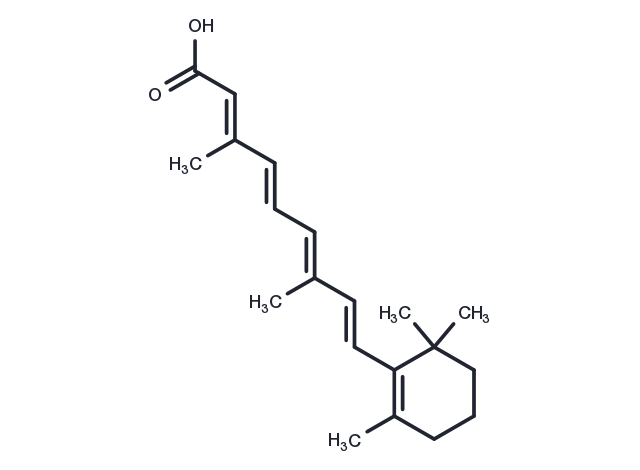keep away from direct sunlight
Powder: -20°C for 3 years | In solvent: -80°C for 1 year
Retinoic acid (Tretinoin), a metabolite of vitamin A, is a natural agonist of the retinoic acid receptor RAR and inhibits RARα/β/γ (IC50=14 nM). Retinoic acid induces cellular differentiation, reduces cellular proliferation, and inhibits tumorigenesis.

| パッケージサイズ | 在庫状況 | 単価(税別) | |||
|---|---|---|---|---|---|
| サンプルについてお問い合わせ | |||||
| 50 mg | 在庫あり | ¥ 7,500 | |||
| 100 mg | 在庫あり | ¥ 11,000 | |||
| 1 mL * 10 mM (in DMSO) | 在庫あり | ¥ 11,500 | |||
| 説明 | Retinoic acid (Tretinoin), a metabolite of vitamin A, is a natural agonist of the retinoic acid receptor RAR and inhibits RARα/β/γ (IC50=14 nM). Retinoic acid induces cellular differentiation, reduces cellular proliferation, and inhibits tumorigenesis. |
| ターゲット&IC50 | RARβ:14 nM, RARγ:14 nM, RARα:14 nM |
| In vitro | Tretinoin prevents skin atrophy induced by corticosteroids in hairless mice. When co-administered with miquimod in guinea pigs, tretinoin induces tattoo fading and moderate pigment clearance histopathologically. Applications of tretinoin on incisions in the skin of 45 CD-1 mice increase fibroblast differentiation and reduce collagen production. In aged male Fischer 344 rats treated with tretinoin, renal cortex protein content is 30% lower compared to controls, potentially due to suppressed expression of tumor necrosis factor-β1 and osteopontin. |
| In vivo | In studies evaluating the impact on glutathione levels and catalase activity, Tretinoin increased both metrics in a time- and dose-dependent manner, offering protective and mitigating effects against H2O2 cytotoxicity in human renal mesangial cells. Treatment with Tretinoin resulted in elevated mRNA levels of catalase and γ-glutamylcysteine synthetase (the catalytic subunit responsible for the rate-limiting step in reduced glutathione synthesis) in cultured mesangial cells. Additionally, Tretinoin upregulated matrix metalloproteinase-8/13 in human keloid-derived fibroblasts. |
| 細胞研究 | Retinoic acid is dissolved in DMSO and stored, and then diluted with appropriate medium before use[3]. P19 cell are induced to undergo neuronal differentiation according to established procedures. Briefly, cells are cultured on 1% agarose-coated 10 cm dishes at 3×10 5 cells/mL in α-minimal essential medium supplemented with 10% FBS. Differentiation is induced by addition of Retinoic acid (1 μM) and medium containing Retinoic acid replaced 2 days later. On day 4, cell aggregates are collected by centrifugation, separated to single cells by trypsin/EDTA treatment, replated onto poly-L-lysine-coated plates, and cultured in α-minimal essential medium supplemented with 10% FBS. On day 6, medium is replaced with neurobasal medium containing B27 supplement and 2 mM GlutaMAX. Medium is replaced every 2 days for an additional week[3]. |
| 別名 | Vitamin A acid, ATRA, all-trans-Retinoic acid, Tretinoin |
| 分子量 | 300.44 |
| 分子式 | C20H28O2 |
| CAS No. | 302-79-4 |
keep away from direct sunlight
Powder: -20°C for 3 years | In solvent: -80°C for 1 year
DMSO: 45 mg/mL (149.78 mM)
Ethanol: 6 mg/mL (19.97 mM)
H2O: < 1 mg/mL (insoluble or slightly soluble)
You can also refer to dose conversion for different animals. 詳細
bottom
Please see Inhibitor Handling Instructions for more frequently ask questions. Topics include: how to prepare stock solutions, how to store products, and cautions on cell-based assays & animal experiments, etc.
Retinoic acid 302-79-4 Autophagy DNA Damage/DNA Repair Metabolism PPAR Retinoid Receptor Endogenous Metabolite Vitamin A acid ATRA inhibit all-trans-Retinoic acid RAR/RXR Tretinoin Inhibitor Retinoic acid receptors Retinoid X receptors Peroxisome proliferator-activated receptors inhibitor
